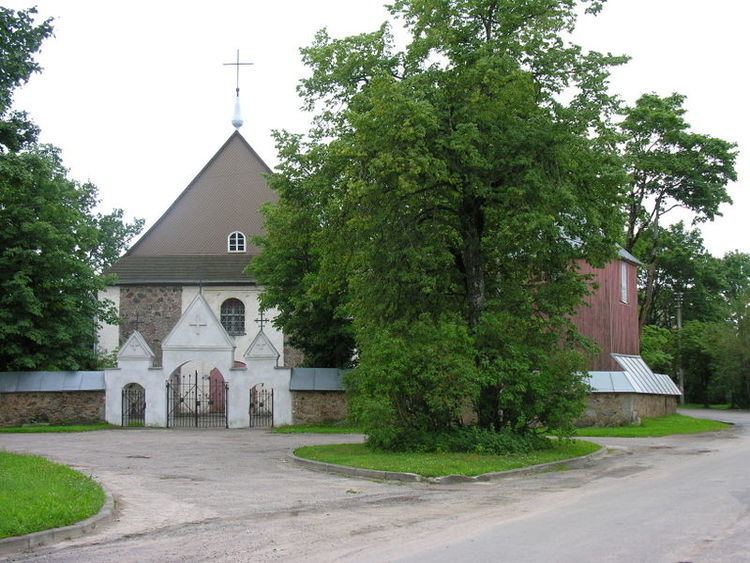Capital of Židikai elderate Local time Monday 5:40 AM | Ethnographic region Samogitia Elderate Židikai elderate First mentioned 1568 Population 440 (2011) | |
 | ||
Weather 6°C, Wind W at 6 km/h, 97% Humidity Municipality Mažeikiai District Municipality | ||
Židikai (Samogitian: Žėdėkā) is a town in Mažeikiai district municipality, Lithuania. It is located 21 km west of Mažeikiai. Židikai is the centre of Židikai elderate. Židikai's Jewish community perished in World War II. However, the village progressed during the Soviet era and is regarded as an urban monument. It is known for being the home of Marija Pečkauskaitė – Šatrijos Ragana, a famous Lithuanian writer (1877 - 1930).
Contents
- Map of C5BDidikai Lithuania
- Etymology
- History
- Progress
- Design
- Culture
- Governance
- Education
- Religion
- Notable citizens
- References
Map of %C5%BDidikai, Lithuania
Etymology
Židikai originates from the words Žydi kaip laukas, or from the word Židikis (meaning tough). Židikai was first mentioned in historic records in 1568 AD.
History
From 1614, Židikai was held by the Kražiai Jesuits. In 1659, during the Northern Wars, Swedish forces burnt down Židikai.
Between 1918 and 1939, when Lithuania was established as an independent state, Židikai prospered. It was a parish centre, a service centre and a centre of governance. Židikai population in the interwar period was nearly 1000.
Before World War II, Židikai had an important Jewish community. According to the census of 1923, there were 893 residents in the shtetl, 799 being Jewish (89%). During summer 1941, hundreds of Jews are murdered in mass executions perpetrated by an einsatzgruppen of Germans and Lithuanians collaborators.
Economic activity in the village stalled. After the war, during the years of Soviet occupation, Židikai developed similarly to other small villages of Lithuania: in 1952, a hospital was established in a former parsonage; in 1954, a secondary school was added to the primary school; and in 1956, Židikai's House of Culture was founded. Židikai's population in 1959 was 429.
After the re-establishment of Lithuania in 1990, Židikai became centre of the Židikai elderate.
Progress
The village hosts three grocery shops, a secondary school, dispensary, library, music school and a cultural centre. Parks were created in 2006 and 2008. In 2007, the President of the Republic of Lithuania approved a new coat of arms for Židikai. On 30 April 2010, a project to renovate the centre of the village began. It was financed by the EU and Mažeikiai District Municipality funds. During the project, the Nepriklausomybės and Turgaus squares as well as the buildings of the cultural centre and Židikai elderate were renovated. Project was finished in 2012. Its value was LTL 731.677. The old town of Židikai is an urban monument with its street plan protected. The large Lithuanian company, ORLEN Lietuva has a presence in the Židikai eldership.
Design
Židikai village has a radial layout, established from the time of the Wallach land reform of 1547. Conserved buildings are predominantly one or two floors high and date to the early 20th century. There are also post World War II and later 20th century buildings. The old part of Židikai is a monument of urbanistics, protected by the state.
Culture
Židikai is noted for its resident of 15 years, the author Šatrijos Ragana. In the centre of Židikai, there is a museum dedicated to her memory. Its exhibits document both her childhood and youth and her later life in the village. The museum is currently closed for renovation and will be opened in December 2016
A cultural centre encourages regional traditions and leisure activities for the youth and other residents of the village. The building of the Centre of Culture was completed in 1967 with two rooms: a larger hall with a capacity of 200 seats for large events, concerts, disco parties etc. and a smaller hall for events such as art exhibitions and board game tournaments.
The Židikai public library opened in 1939. In 2004, the library had about 9000 documents and books in its holdings. In 1994, the library moved to new premises in the Centre of Culture building. The library is a branch of Mažeikiai public library.
Governance
Židikai is the centre of Židikai eldership and the largest town within the eldership. The area of the eldership is 198 km2 (76.45 sq mi). The population density of the eldeship is 3.044-man/km². In 2009, five sub-elderships were established, one of which was located in Židikai village.
Education
The Židikai Marija Pečkauskaitė secondary school opened in 1865 and is the oldest school in the Mažeikiai District Municipality. In Židikai village, there is a branch of the Mažeikiai music school which was founded in 1986. There, students have an opportunity to learn to play the piano, accordion, saxophone or guitar as well as learn music theory and history. It is located in the Židikai Center of Culture and public library building.
Religion
Židikai has one Roman Catholic church and one chapel (in the cemetery of the village). The first church in Židikai was built in 1636 by the Kražiai Jesuits who held the town from 1614. The parish of Židikai was established in 1853. The existing St. John the Baptist's church was built in 1821 and St. Ann's Chapel was built in 1941. The most important religious festival and the biggest festival of the village is Saint Ann's Feast celebrated annually during the last weekend of July. On the Sunday of the feast, Mass is celebrated in front of the cemetery chapel.
